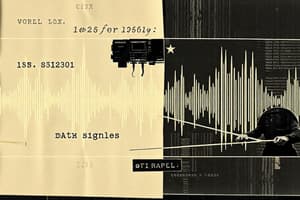Podcast
Questions and Answers
What is the primary purpose of pulse-code modulation (PCM) in data communication?
What is the primary purpose of pulse-code modulation (PCM) in data communication?
- Converting discrete numerical values into continuous audio or video streams
- Establishing and managing sessions between communicating entities
- Facilitating the physical transmission of data
- Ensuring reliable data delivery even if parts of the signal are lost (correct)
Which layer of the OSI reference model is responsible for handling the actual transmission of bits and bytes?
Which layer of the OSI reference model is responsible for handling the actual transmission of bits and bytes?
- Data link layer
- Physical layer (correct)
- Transport layer
- Network layer
In data communication, what is the function of the session layer in the OSI model?
In data communication, what is the function of the session layer in the OSI model?
- Ensuring reliable data delivery even if parts of the signal are lost
- Facilitating the physical transmission of data
- Handling error detection and correction mechanisms
- Managing the establishment and management of sessions between communicating entities (correct)
Which term refers to converting continuous analog signals into discrete numerical values for digital transmission?
Which term refers to converting continuous analog signals into discrete numerical values for digital transmission?
What is a key advantage of using guided media for transmission in data communication?
What is a key advantage of using guided media for transmission in data communication?
What is the main difference between guided media and unguided media in data communications?
What is the main difference between guided media and unguided media in data communications?
Which type of transmission media is more suitable for handling high bandwidth communication such as in LANs?
Which type of transmission media is more suitable for handling high bandwidth communication such as in LANs?
In data communications, why do unguided media have a limited range compared to guided media?
In data communications, why do unguided media have a limited range compared to guided media?
What is the primary function of digital transmission in data communications?
What is the primary function of digital transmission in data communications?
Why are twisted pair, coaxial cable, and optical fiber examples of guided media?
Why are twisted pair, coaxial cable, and optical fiber examples of guided media?
Study Notes
Data Communications Overview
Data communication is the process of transmitting information from one location to another, often within a digital network. This process involves several aspects, including different types of transmission media, digital transmission techniques, and network structures. Understanding these components helps us navigate the complexities of modern data exchange and ensures effective communication within computer networks.
Types of Transmission Media
Transmission media refers to the physical paths along which signals travel during data transfer. There are two general categories: guided media and unguided media.
Guided Media
Guided media require a physical pathway to carry signals, typically made of copper wires or fiber optic cables. Examples include twisted pair, coaxial cable, and optical fiber. These media can handle high bandwidth communication due to minimal signal interference and are commonly used for local area networks (LANs).
Unguided Media
Unguided media operate without a fixed pathway, making them suitable for wide area network (WAN) communication. Radio waves and microwaves fall into this category. Signal strength decreases as distance increases, which limits the range of unguided media compared to guided media.
Digital Transmission
Digital transmission converts analog signals into binary code for accurate transmission over various media. Techniques like pulse-code modulation (PCM) convert continuous audio or video streams into discrete numerical values. This digitalization allows error detection and correction mechanisms, ensuring reliable delivery of data even if parts of the signal are lost during transmission.
Unfolding the Layers of Data Communication
To facilitate better comprehension, the Open System Interconnection (OSI) reference model is frequently employed. This model consists of seven layers, each addressing specific aspects of communication. For instance, the physical layer handles the actual transmission of bits and bytes, while higher levels such as the session layer manage the establishment and management of sessions between communicating entities.
Conclusion
Understanding the nuances of data communication is crucial in contemporary society where information flows constantly. By grasping the fundamentals of media types, digital transmission, and network structures, individuals can appreciate the complexity behind seemingly simple tasks such as sending emails or streaming videos online.
Studying That Suits You
Use AI to generate personalized quizzes and flashcards to suit your learning preferences.
Description
Test your knowledge on data communication basics including transmission media, digital transmission, OSI reference model, and the importance of understanding different layers in modern networks.



